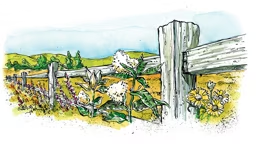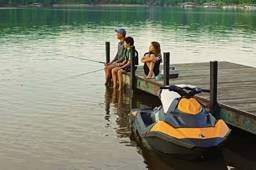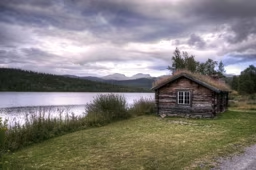In the world of stormwater control, there are two golden rules: Go as far upstream as possible, and let gravity do the work for you. In other words, the best approach is to not let water reach your home site in the first place, and use passive drainage to accomplish that goal.
The same principles apply to reliably keeping your cabin dry. Whether you have a slab, basement, or crawl space, you want to keep the water as far away as possible. It makes little sense to install a sump pit and pump (which can and will fail when there’s a power outage) when a little landscaping can prevent the water from reaching your cabin in the first place.
The following are a few tips, starting upstream and working down the line. If you need to perform extensive dirt work, be sure to check with your local or state government for the necessary permits first.
The same principles apply to reliably keeping your cabin dry. Whether you have a slab, basement, or crawl space, you want to keep the water as far away as possible. It makes little sense to install a sump pit and pump (which can and will fail when there’s a power outage) when a little landscaping can prevent the water from reaching your cabin in the first place.
The following are a few tips, starting upstream and working down the line. If you need to perform extensive dirt work, be sure to check with your local or state government for the necessary permits first.
FRENCH DRAINS
French drains are a great option to route rainwater away from your foundation. This is a simple gravity system, consisting of perforated pipe covered by a layer of crushed rock. You’ll need to expose the downstream end of the piping system, commonly referred to as “daylighting” the pipe. You can substitute French drains for swales or ditches to maintain a level grade – a big plus when it comes time to mow the yard.
Did you know? Contrary to what you might think, French drains have their roots in America. While he didn’t invent them, French drains were first popularized by a Massachusetts lawyer, famer and assistant Secretary of the U.S. Treasury, Henry Flagg French, in his 1859 book “Farm Drainage.” Now that’s French literature any good DIYer can appreciate!
French drains are a great option to route rainwater away from your foundation. This is a simple gravity system, consisting of perforated pipe covered by a layer of crushed rock. You’ll need to expose the downstream end of the piping system, commonly referred to as “daylighting” the pipe. You can substitute French drains for swales or ditches to maintain a level grade – a big plus when it comes time to mow the yard.
Did you know? Contrary to what you might think, French drains have their roots in America. While he didn’t invent them, French drains were first popularized by a Massachusetts lawyer, famer and assistant Secretary of the U.S. Treasury, Henry Flagg French, in his 1859 book “Farm Drainage.” Now that’s French literature any good DIYer can appreciate!
1. Walk to the highest point of your property that’s in the same drainage as your cabin. Sip a cup of coffee and really survey the lay of the land. More than a few people have spent thousands of dollars on waterproofing, pumps, drain tiles and other devices in unsuccessful attempts to get rid of water, only to find that a few yards of excavation or well-placed fill easily shifts all that problem water away.
2. Now take a look at the ground near the exterior of your foundation. The ground should gently slope away from the foundation on all sides; for many lakeside cabins, the structure is on a slope. In clay or other impermeable soils, this means the upslope side of the cabin is essentially a temporary dam during heavy rain events. If that’s the case, you can add fill to divert the water to either side of the cabin, or excavate shallow swales to pass the water on either side.
3. Gutters are by far one of the best ways to prevent water from reaching your cabin. However, many people don’t pay enough attention to the downspout length. If you don’t have a good slope away from the cabin, add downspout extensions to get all that roof water far away from the foundation.
2. Now take a look at the ground near the exterior of your foundation. The ground should gently slope away from the foundation on all sides; for many lakeside cabins, the structure is on a slope. In clay or other impermeable soils, this means the upslope side of the cabin is essentially a temporary dam during heavy rain events. If that’s the case, you can add fill to divert the water to either side of the cabin, or excavate shallow swales to pass the water on either side.
3. Gutters are by far one of the best ways to prevent water from reaching your cabin. However, many people don’t pay enough attention to the downspout length. If you don’t have a good slope away from the cabin, add downspout extensions to get all that roof water far away from the foundation.

 Jay Smith (illustration)
Jay Smith (illustration) 







